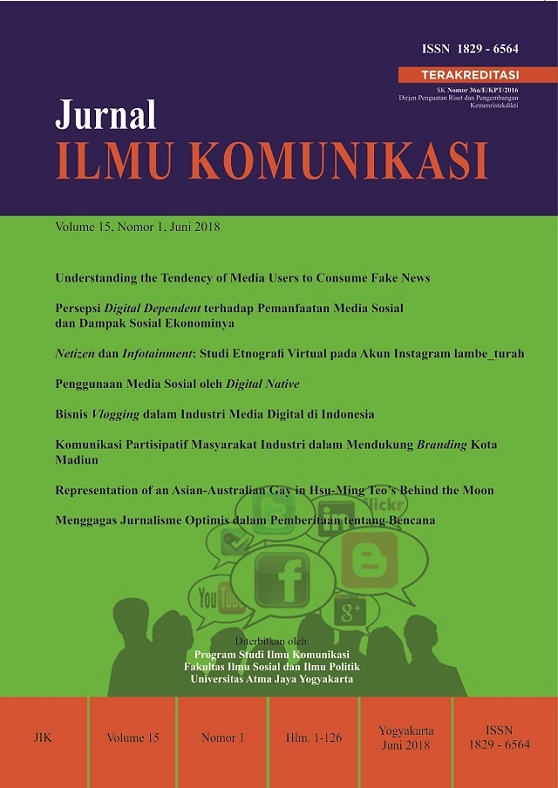Understanding the Tendency of Media Users to Consume Fake News
DOI:
https://doi.org/10.24002/jik.v15i1.1322Keywords:
fake news, media consumption, media trustworthinessAbstract
This research investigates the ways in which different groups of media users have different tendencies in consuming and believing fake news. These tendencies are examined through: (1) analysis of association of age and income level with the pattern of media consumption; (2) analysis of association of age and income level with types of media that is perceived as the most trustworthy. Using systematic random sampling, this study examines 400 households in Semarang, Central Java, with level of confidence of 95%.
References
Allcott, H. & Gentzkow, M (2017) Social Media and Fake News in the Election 2016, Journal of Economic Perspectives., 32 (2) 211–236
Clark, D. B., & Slotta, J. D. (2000). Evaluating media-enhancement and source authority on the Internet: the Knowledge Integration Environment. International Journal of Science Education, 22(8), 859-871.
Chadwick, A. (2011) The Political Information Cycle in a Hybrid News System: The British Prime Minister and the “Bullygate” Affair, International Journal of Press/Politics 16(1) 3 –29
Chadwick, A. (2013) The Hybrid Media System: Politics And Power, New York: Oxford University Press
Fallis, D. (2015) What Is Disinformation? in Ken Herold (Ed.) Library Trends: Exploring Philosophies of Information, 63 (3) 401–426
Giglietto, F., Iannelli, L., Rossi, L., Valeriani, A., (2016) Fakes, News and the Election: A New Taxonomy for the Study of Misleading Information within the Hybrid Media System
Hermida, A. (2010). "From TV to Twitter: How Ambient News Became Ambient Journalism"M/C Journal, 13 (2).
Hermida, A., Fletcher, F., Korell, D., & Logan, D. (2012). Share, Like, Recommend. Journalism Studies, 13(5-6), 815-824.
Karlova, N.A., Fisher, K.E. (2013), A social diffusion model of misinformation and disinformation for understanding human information behaviour, Information Research,18 (1)
Kompas, Hoaks Politik Dominan, Kamis, 16 Feb 2017, hal.13
Kompas, Hoaks, dari Era Soekarno Hingga Kini, Minggu, 26 Feb 2017, hal. 2
Lodge, M., & Taber, C. (2000). Three steps toward a theory of motivated political reasoning. In A. Lupia, M. D. McCubbins, & S. Popkin (Eds.), Elements of Reason: Cognition, Choice, and the Bounds of Rationality (pp. 183-213). Cambridge: Cambridge University Press.
Masyarakat Telematika Indonesia (MASTEL) (2017) Hasil Survey Mastel Tentang Wabah Hoax Nasional, Jakarta: Mastel
Meyer, G. W. (1994). Social Information Processing and Social Networks: A Test of Social Influence Mechanisms. Human Relations; Studies towards the Integration of the Social Sciences, 47(9), 1013-1047.
Rojecki, Andrew, Meraz, Sharon (2016) Rumors and factitious informational blends: the role of the web in speculative politics, New Media & Society. 18(1) 25–43.
Rieh, S. Y. (2002). Judgment of information quality and cognitive authority in the Web. Journal of the American Society for Information Science. American Society for Information Science, 53(2), 145-161.
News Media Association (2017) Culture, Media, and Sport Select Committee ‘Fake News’ Inquiry: New Media Association Response. Wales: NMA
Schifferes, S., Newman, N. (2013) Verifying News on the Social Web: Challenges and Prospects, International World Wide Web Conference Committee, May 13–17, 2013, Rio de Janeiro, Brazil.
Stroud, N. J. (2007). Media Use and Political Predispositions: Revisiting the Concept of Selective Exposure. Political Behavior, 30 (3), 341-366.
Stanford History Education Group (2016) Evaluating Information: The Cornerstone of Civic Online Reasoning, Executive Summary
Downloads
Published
Versions
- 2022-03-15 (2)
- 2018-06-02 (1)
How to Cite
Issue
Section
License
Copyright (c) 2018 Jurnal ILMU KOMUNIKASI

This work is licensed under a Creative Commons Attribution 4.0 International License.
Jurnal ILMU KOMUNIKASI is an academic journal. As such, it is dedicated to the open exchange of information. For this reason, JIK is freely available to individuals and institutions. Authors who publish in Jurnal ILMU KOMUNIKASI will release their articles under the Creative Commons Attribution (BY) License. This license allows anyone to copy and redistribute the article in any medium or format as well as remix, transform, and build upon the material for any purpose, even commercially as long as they credit the authors for the original creation. For details of the rights authors grants users of their work, see the "human-readable summary" of the license, with a link to the full license. (Note that "you" refers to a user, not an author, in the summary)
 This work is licensed under a Creative Commons Attribution 4.0 International License.
This work is licensed under a Creative Commons Attribution 4.0 International License.














